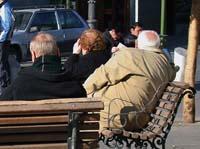More frequent rheumatic diseases

Under the word rheumatism, about 200 diseases have a common characteristic: they affect the locomotor apparatus. Among these diseases, the most common are osteoarthritis and osteoporosis. Rheumatoid arthritis, fibromyalgia, gout, or gout are less common. Most of these diseases are chronic and deteriorate the quality of life of the patient due to the pain and mobility problems that affect him.
Arthrosis
It is due to the wear of the joint cartilage, that is, the substance that somehow covers the bones that come into contact in a joint deteriorates, so the friction between them is usually greater than normal.
It is a chronic degenerative disease whose main symptoms are pain and loss of mobility. It mainly appears on the knees, hands, hip, spine and thumb of the foot.
Being a degenerative evil, he has no remedy. However, it can slow the progression of the disease and relieve symptoms. The medicines that protect cartilage in recent years have been the ones that have introduced the greatest novelty. These drugs, in addition to preventing disease and stabilizing evolution, can partly 'repair' cartilage and bone injuries.
Osteoporosis
It also affects men, but osteoporosis is mostly a female disease and appears especially after menopause. It is due to the decrease in bone mass. The bone becomes more fragile and increases the risk of fractures. Osteoporosis itself does not produce pain, but it does produce bone fractures.
Because it is an alteration associated with menopause, hormone replacement therapy can delay the evolution of the disease by the influence of estrogens. On the other hand, drugs against bone resorption, such as alendronates, reduce the process of bone destruction and reduce the risk of fracture.
Rheumatoid arthritis
It is a disease in which the joints increase and, more specifically, the synovial membrane increases. But also to the bone, cartilage and other organs of the body (myocardium, skin, etc.) affects them. The main symptoms are pain, deformation and loss of mobility of the affected joint.
At the moment, this disease has no remedy. Treatments try to reduce inflammation to improve joint mobility. For this purpose, non-steroidal anti-inflammatory drugs, corticosteroids and anti-rheumatic drugs that alter the disease are mainly used.
Fibromyalgia

It affects muscles and fibrous tissue. It produces pain in various parts of the body, of varying intensity and general feeling of fatigue or exhaustion. It can also cause memory alterations and depression.
In this case there is no remedy, but symptoms can be alleviated
with appropriate treatment: physical measures (local heat, massage and muscle toning exercises) are combined with drugs such as muscle sedatives, analgesics and local anesthetic or corticosteroid infiltrations. And, if necessary, anxiolytics or antidepressants may be used.
Drop
Uric acid crystals appear in some tissues such as the joints of the feet, hands, and legs. The main symptoms are pain, swelling of the joint, fever, and superficial lumps (especially on the thick toe).
Anti-inflammatory drugs are most commonly used in the acute phase of the disease to relieve symptoms. It is recommended to drink plenty of fluids and avoid alcohol, red meat, coffee and seafood. The diet should be rich in vegetables, fresh fruit and whole foods.
Chondrocalcinosis
Calcium salts are deposited in the articular cartilage and finally the cartilage deteriorates, making it more fragile and may appear symptoms similar to osteoarthritis or arthritis.
If condocinosis does not give symptoms, general measures are sufficient (avoid overweight and avoid joint overload as much as possible). In case of pain, treatment is the same as in case of osteoarthritis.





